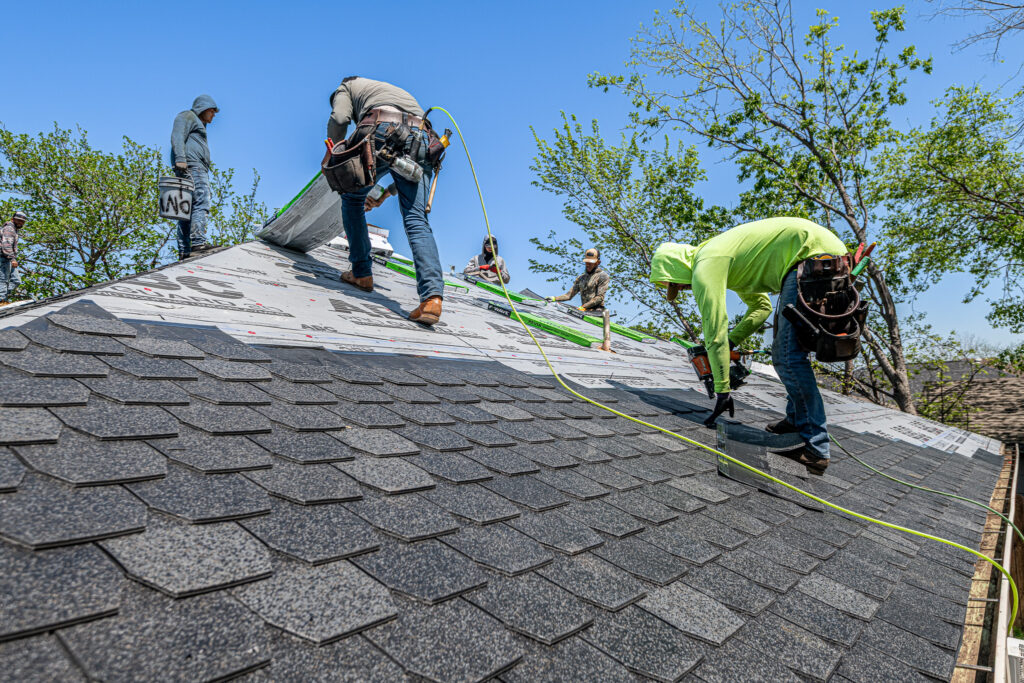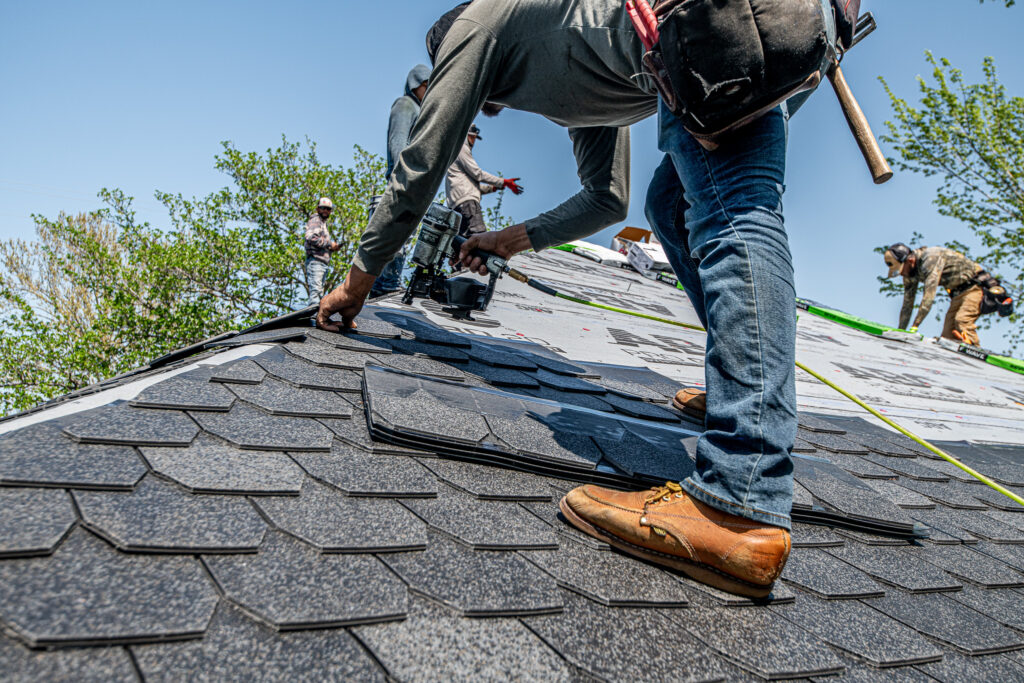In a hurry? Here’s a TL;DR (too long, didn’t read): F-Wave Shingles are Class A fire-rated, Class 4 hail-rated, resistant to 130MPH winds, and come with a 5-year hail warranty. While they cost on average 2–3× more upfront than traditional asphalt, F‑Wave roofs potentially save money by avoiding insurance deductibles, reducing frequent replacements, and qualifying for insurance discounts of 10–30%. Not all roofers are trained to install F-Wave, but Texas Direct can help.
Want a real F-Wave shingles price in 60 seconds? Click the “Free roof quote” bubble in the bottom right and provide your info, then look at the “premium roof” option in the report.

Welcome to the most comprehensive F-Wave shingles review you’ll find anywhere—a no-nonsense, roofer-to-homeowner breakdown of a product that’s shaking up the roofing world. At Texas Direct Roofing and Construction, we’ve seen the industry’s chaos firsthand: skyrocketing insurance deductibles, traditional asphalt shingles failing faster than ever, and homeowners caught in a cycle of insurance claims and frustration. F-Wave shingles might just be the solution to stabilize this mess—not just for us, but for every storm-weary homeowner across the nation.

F Wave Shingles Review: Why F-Wave Matters Now
Across the U.S., from the hail-battered Midwest to the hail-ravaged Texas, homeowners are facing a roofing reckoning. Traditional asphalt shingles—once the go-to—are crumbling under modern weather extremes. Storms are fiercer, insurance premiums are climbing (up 30-40% in many states since 2020), and deductibles are ballooning—$5,000 is now standard, $10,000 isn’t rare, and we’ve seen outliers hit $25,000+.
F-Wave shingles aren’t just another product—they’re a rebellion against this chaos. Made from a synthetic polymer blend, they’re engineered to outlast, outperform, and outsmart the storms and insurance traps plaguing homeowners nationwide. With extremely low maintenance requirements compared with traditional shingles and superior resistance to extreme weather conditions, people are really talking about this new option. This F-Wave shingles review will show you why they’re worth your attention, whether you’re in Texas, Florida, Colorado, or anywhere else in the USA.
What Are F-Wave Shingles? The Synthetic Shingles Specs That Change the Game
Let’s cut through the noise. F-Wave shingles aren’t asphalt—they’re a high-tech, commercial-grade synthetic roofing system built for the long haul. Here’s what makes them stand out:
Class 4 Impact Resistance: The gold standard. These shingles shrug off hail up to 2 inches (covered by a 5-year hail warranty) and have been tested and survived against even larger stones. Asphalt shatters; F-Wave endures.
Windproof to 130 mph: Hurricanes, tornadoes, or just a nasty gust—F-Wave stays locked down when harsh conditions blow others away.
50-Year Lifespan: Traditional shingles limp to 15-25 years in calm climates, far less in storm zones. F-Wave’s durability doubles or triples that, slashing replacement costs.
No Granule Loss: Asphalt shingles shed granules like a dog sheds hair in summer, degrading fast. F-Wave’s single layer surface stays intact, resisting UV rays, cracking, and curling.
Lightweight Yet Tough: F-Wave synthetic shingles are easier to install than heavy alternatives like slate, but with the same premium hail resistance and resistance to wind.
Available in styles mimicking slate, hand-split shake shingles, or regular asphalt shingles, they blend aesthetics with exceptional durability. This isn’t hype—it’s physics, and it’s why F-Wave is rewriting the roofing rulebook.
Insurance Pain Points: How F-Wave Fights Back
The insurance industry’s shift has homeowners on edge, and we get it—because we’re in the trenches with you. Thanks to extreme weather, insurance deductibles are no longer “affordable.” A $2,000 deductible feels like a unicorn when $4,000-$10,000 is the norm and $25,000 policies are popping up in high-risk zones. Premiums? Up 33% nationwide since 2019, per the Insurance Information Institute. File a claim too often, and you’re labeled a “risk,” facing cancellation or rates that’d make a loan shark blush.
F-Wave shingles flip the script:
Fewer Claims, Fewer Deductibles: If your roof survives the storm, you don’t pay a dime—no $4,000 hit, no $25,000 gut punch. This alone may justify the cost in hail-heavy states like Texas or Oklahoma or wind-swept coastal areas.
Premium Discounts: Insurance Carriers love Class 4 roofs. Discounts range from 10-30% (sometimes more in states like Texas or Florida), cutting your annual bill and offsetting the upfront price over time.
Break the Replacement Cycle: A roof that lasts 50 years vs. 15 means fewer claims, fewer deductibles, and less insurer scrutiny. It’s stability in an unstable world.
We’ve seen clients save thousands over a decade, turning a “luxury” roof into a financial lifeline. Check with your agent—those discounts are real, and they stack up.
The Cost Question: Worth the Investment?
Let’s talk money, because every F-Wave shingles review hinges on this. Yes, F-Wave costs more upfront—2-3 times the price of basic asphalt shingles, depending on your region and roof size. A roof might run you $15,000-$25,000 for asphalt vs $30,000-$50,000 with F-Wave. Sticker shock? Sure. But here’s the math:
Storm Scenario: A hailstorm trashes your asphalt roof. You pay a $5,000 deductible, replace it, and repeat every 10 years. That’s $25,000+ out of pocket, plus rising premiums. F-Wave takes the hit, you pay $0, and it’s still kicking 40 years later.
Insurance Savings: A 20% premium discount on a $2,000 annual policy saves $400/year—$20,000 over 50 years. Add avoided deductibles, and the gap narrows fast.
Replacement Costs: Asphalt roofs need swapping every 10-15 years—three to four times in F-Wave’s lifespan. At $7,500 a pop, that’s $22,500 vs. one F-Wave install.
The catch? You need the cash or financing upfront. At Texas Direct Roofing and Construction, we offer flexible plans to spread the cost, because we believe this product shouldn’t be out of reach.
Getting the Most Bang for Your Buck: F-Wave Pricing Hacks
If the price tag for F-Wave shingles has you hesitating, you’re not alone. But smart shopping can shave thousands off your final bill—or at least soften the sting. Here’s how savvy homeowners approach it:
- Off-Season Advantage: Roofing’s busy season is late spring through early fall. Opting for installation in the winter or late fall? Contractors may offer substantial discounts to keep crews busy, and manufacturers like F-Wave, CertainTeed, or GAF sometimes roll out seasonal promotions.
- Ask About Rebates: Don’t leave money on the table. Buzz your contractor about manufacturer rebates, limited-time coupons, or local utility incentives for storm-resistant upgrades—these pop up more often than you think.
- Explore Financing: If sticker shock is the only thing holding you back, see what payment plans are offered. Many companies have zero-interest or low-interest financing options, especially if you have good credit.
- Negotiate the Extras: Some bids sneak in charges for small repairs, haul-off, or “upgraded” underlayments. Ask what’s truly necessary—you might find areas to pare back or bundle for savings.
A little legwork could be the difference between paying full price and scoring your F-Wave roof for much less. Every dollar saved upfront helps you enjoy that premium protection without losing sleep over the bill.
Labor Costs: The Price of Precision
Alright, so what’s the labor bill look like for F-Wave shingles? Expect rates to run in the ballpark of $3 to $7 per square foot, depending on where you live and how tricky your roof is. Unlike basic asphalt installs (which nearly any roofer can tackle after their morning coffee), F-Wave demands a crew with real know-how.
Why the premium? It all comes down to craftsmanship. These aren’t “slap ‘em on and forget it” shingles. The installation process calls for pros who understand the unique properties of F-Wave’s synthetic design—think Tesla mechanics versus your uncle’s quick oil change shop. Labor costs reflect the time and expertise required to ensure your investment actually pays off: watertight, storm-proof, and built to last.
Factors that impact your final bill:
- Roof complexity: Steep pitches, lots of valleys or dormers, or intricate architectural details mean more hours on the clock.
- Local market rates: Labor costs are always higher in cities like Dallas or Miami than in smaller towns.
- Experience matters: Hiring true F-Wave pros (and you absolutely should) can cost a little more, but it saves headaches—and callbacks—down the road.
Bottom line? Yes, labor for F-Wave is higher than bargain-basement installs, but you’re paying for peace of mind and long-term value. If you’re getting quotes, ask about installer experience—just as you would when choosing a builder for your forever home.
The Hidden Cost of Asphalt: Landfills and Climate Chaos
Here’s a dirty secret the roofing industry doesn’t shout about: asphalt shingles are an environmental disaster. Every year, 11 million tons of shingle waste clog U.S. landfills—about 8% of all construction debris—most of it from storm-damaged roofs ripped off after just 7-10 years in rough climates. That’s a mountain of petroleum-based junk sitting there, leaching toxins, and taking centuries to break down. And it’s not a one-time problem. In hail or wind-prone areas, you’re replacing that roof every decade, piling more trash on the heap.
F-Wave shingles flip that on its head. One install lasts 50 years, slashing the need for replacements. No granules mean less waste over time, and their synthetic makeup skips the oil-heavy production mess. It’s not a perfect green fix—manufacturing still has a footprint—but it’s a hell of a lot better than the asphalt landfill grind. Choosing F-Wave isn’t just about surviving storms; it’s about not screwing over the planet your kids will inherit.

F Wave Shingles Review Downsides: What’s the Catch?
No product’s perfect, and F-Wave has its quirks:
Higher Initial Cost: It’s a hurdle, no denying it. Budget-tight homeowners might balk.
Installer Availability: Not every roofer knows the F-Wave installation process. You need a pro who’s trained—luckily, we’ve got you covered.
Aesthetic Fit: Some love the modern look of synthetic roofing shingles; others miss the vibe of traditional roofing materials. Styles vary, so check samples.
These aren’t dealbreakers—they’re trade-offs for a roof that laughs at storms while others crumble.
Nationwide Relevance: F-Wave Across the U.S.
F-Wave isn’t a regional gimmick—it’s sold coast to coast, tackling every climate:
Hail Zones (Midwest, Plains): Hail’s the #1 roof killer. F-Wave’s Class 4 rating shines here.
Hurricane Coasts (Gulf, Atlantic): 130 mph wind resistance meets Category 3 storms head-on.
Sunbelt (Southwest): UV resistance keeps it from frying in 100°F+ summers.
Snow Country (North): Tough enough for freeze-thaw cycles without cracking.
Wherever you are, F-Wave adapts, outlasting local weather woes and insurance headaches.
Why This Matters to Us—and You
At Texas Direct Roofing and Construction, we’re not just selling roofs—we’re fighting for an industry on the brink. Homeowners deserve better than fragile shingles and predatory insurance games. F-Wave isn’t a cure-all, but it’s a damn good start. We’ve installed it, tested it, and watched it save our clients from the storm-claim-repeat nightmare. This F-Wave shingles review isn’t hype—it’s a call to action.
F Wave Shingles Review: The Verdict:
If you’re sick of roofs that fail, deductibles that sting, and premiums that soar, F-Wave shingles are your ticket out. They’re tough, smart, and built for a future where storms don’t dictate your wallet. The cost stings upfront, but the savings—financial and emotional—pile up fast. F-Wave is the roof our industry desperately needs.
Ready to ditch the chaos? Call Texas Direct Roofing and Construction today. We’ll walk you through pricing, financing, and insurance hacks to make F-Wave yours. This isn’t just a roof—it’s your rebellion against a broken system. Let’s build it together.

